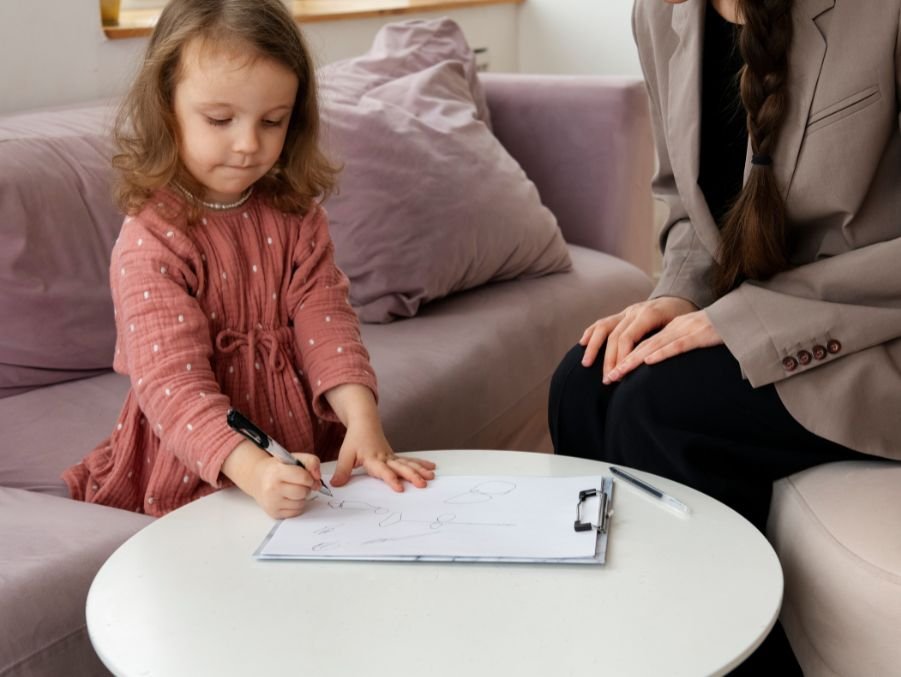At the age of 13, Arjun’s behaviour became a serious concern for his parents and teachers. He frequently got into fights at school. He lied a lot and stole small items from the local shop and his home. Despite all the attempts to discipline him, his actions grew more and more aggressive, which eventually led him into legal trouble. Seeing the gravity of the situation, his parents decided to visit a psychologist who gave the diagnosis of Conduct Disorder.
Conduct Disorder is a mental health disorder that is primarily observed in children. It is characterised by persistent and repetitive violation of rules and disregard for the rights of others. Children with Conduct Disorder often portray aggressive behaviour towards people and animals. They often bully people, threaten them and intimidate others. They often initiate and get into physical fights.
There is also a higher tendency for them to deliberately destroy the property of other people which reflects a disregard for other people’s rights or properties. They also tend to steal goods. And they also exhibit serious violations of rules at home as well as at school. Conduct Disorder is often seen as an early manifestation of broader behavioural issues and can be a precursor to more conditions such as antisocial personality disorder in adulthood.
This disorder often begins when the child is about 12 years old and has a lifetime prevalence of 10%. Conduct Disorder is more common in boys (about 12%) as compared to girls (about 7%). Understanding Conduct Disorder is very crucial due to its potential long-term consequences. Conduct Disorder affects not only the individual but also their family, schools, and communities, leading to broad social challenges, including criminal activities. Early diagnosis and intervention can prevent these negative outcomes and support individuals in leading a more positive and fulfilling life.
Symptoms
According to the Diagnostic and Statistical Manual of Mental Disorders (DSM5) for the diagnosis of Conduct Disorder, one must display three of the following behaviours within the past 12 months with at least one behaviour present in the past six months. Aggression to People and Animals:
- Bullies, threatens or intimidates others.
- Initiates physical fights.
- Has used a weapon that can cause serious harm (e.g., a bat or knife).
- Has been physically cruel to people or animals.
- Has forced someone into sexual activity.
Destruction of Property:
- Has deliberately engaged in fire-setting to cause damage.
- Has deliberately destroyed others’ property in other ways.
Deceitfulness or Theft:
- Has broken into someone else’s house, building, or car.
- Often lies to obtain goods, favours, or to avoid obligations (“cons” others).
- Has stolen items of nontrivial value without confronting a victim (e.g., shoplifting).
Serious Violations of Rules:
- Often stays out at night despite parental prohibitions, beginning before age 13.
- Has run away from home overnight at least twice while living in the parental home.
- Is often truant from school, beginning before age 13.
To be diagnosed, these behaviours must cause significant impairment in the individual’s functioning, and the behaviours should not be better explained by another mental disorder.
Causes and Risk Factors
Disorders can arise from a complex interplay of biological, environmental, and psychosocial factors.
Biological elements
Genetic Disposition:
Research indicates that genetic factors can contribute significantly towards the development of Conduct Disorder. Studies done on twins and families have shown that there is a high heritability rate for antisocial behaviour ranging from 40% to 60% variance to genetics. Children with a family history of Conduct Disorders, antisocial behaviour or substance use disorders are at a higher risk of developing Conduct Disorders.
Brain Structure:
Neuroimaging studies have identified certain abnormalities in the brain structures associated with impulse control, emotional regulation and aggression in individuals with Conduct Disorder. For instance, there is reduced activity in the prefrontal cortex in children with Conduct Disorder, and this part of the brain is primarily responsible for decision-making and impulse control. Researchers have also found that there are certain abnormalities in the amygdala, which play a crucial role in emotional responses and have been linked to increased aggression and emotional dysregulation.
Neurochemical factor:
Certain neurotransmitters, such as serotonin and dopamine have been implicated in the research for Conduct Disorder. The researchers have shown that low levels of serotonin are often associated with impulsivity and low emotional regulation, and on top of that, the dysregulation of the dopamine systems may affect the reward system in a way that can lead to higher risk-taking behaviours.
Environmental factors


Family environment:
Factors such as parental neglect, abuse, inconsistent discipline, and lack of supervision are significant contributors to the development of Conduct Disorder. Children raised in abusive homes lack the support, which is needed for the healthy development of the child. Additionally, families with a history of antisocial behaviour can also perpetuate the cycle of dysfunction that can increase the risk of Conduct Disorder
Parenting styles:
As we know, there are four parenting styles: authoritarian, permissive, authoritative, and neglectful. Studies have shown that authoritative parenting, characterised by structure, can help mitigate the risk of developing Conduct Disorder. In contrast, authoritarian parenting, which is characterised by strict and punitive parenting, can exacerbate the symptoms of Conduct Disorder. Permissive parenting style, which lacks discipline can also worsen the behavioural issues. Apart from that parents who struggle with any kind of substance use can also contribute to the development of Conduct Disorder in children.
Social-Economic Status:
Individuals from lower socio-economic backgrounds are at a higher risk of Conduct Disorders. This is due to factors such as limited access to quality education, healthcare and social support. Economic hardship can also increase stressors within the families which can result in conflict and dysfunction.
Exposure to trauma:
Children who experience trauma, such as physical, emotional, mental, or sexual abuse, or community violence, often show long-lasting emotional and behavioural dysfunction. Children who experience trauma are more likely to exhibit aggressive behaviours, and this can set the stage for the development of Conduct Disorder.
Psychosocial factors
Peer influence:
An individual who often engages in delinquent behaviour can reinforce the antisocial actions, normalising rules, and breaking behaviours. Children with Conduct Disorder may also gravitate more towards friend groups that share similar attitudes and behaviour, which perpetuates the cycle of delinquency.
Educational background:
Struggling academically, such as having poor performance or frequent school disruptions, are both factors and consequences of Conduct Disorder. Children with Conduct Disorder often face difficulties in school in part due to their behavioural difficulties, which can further lead to social isolation, reinforcing the antisocial behaviour.
Community context:
Communities with high levels of crime rates and few positive role models can provide an environment that often normalises antisocial behaviours. Community factors such as the availability of recreational activity, social cohesion, availability of positive roles, models etc influence the risk of developing conduct
In essence, Conduct Disorder can arise from the multifaceted interaction between the biological, environmental and psychosocial factors. Understanding all these factors can help us guide effective interventions and take preventive measures for individuals at risk of developing Conduct Disorder.
Is Conduct Disorder Preventable?
Conduct Disorder arises from a complex interplay between various factors. However, to some extent, it can be preventable by focusing on and addressing certain risk factors that are associated with its development, such as earlier identification of children with Conduct Disorder can lead to early interventions. Schools, parents, and caregivers can use standardised screening methods to detect the early signs of these behavioural problems. This can then eventually lead to early interventions which are targeted at children who are at risk. These early interventions can include behavioural therapy, social skills, training, or support from parents.


Once it is identified, parents can help mitigate its effect. Studies have shown that parenting style is crucial for the development of conduct disorder. Certain programs can teach individuals positive parenting styles such as consistent discipline, setting clear rules and rewarding good behaviour can significantly reduce the risk. Schools can also offer programmes that teach children essential social skills, such as empathy, problem-solving, and conflict resolution. Learning these skills can help children manage their emotions and interactions, leading to reduced aggression and antisocial behaviour. Schools can also take anti-bullying initiatives, which can foster a more inclusive school environment and prevent conduct disorder.
Certain community-based interventions can also be implemented. These interventions or programmes can focus on neighbourhood and safety, enhance community cohesion and provide resources for families to contribute to reducing incidents of conduct disorder. For example, initiatives that offer parenting workshops, mental health, sport or recreation facilities can help build a more supportive environment for children. While it may not be possible to entirely prevent Conduct Disorders, especially when genetic factors are involved, many of the risk factors of conduct disorders can be mitigated through early intervention support, parenting, and community-based programs.
Treatment Approaches
The primary treatment for Conduct Disorder is multiple forms of psychotherapy for children’s families, as well as community-based treatments.
Therapeutic Interventions
Behavioural Therapy:
Behavioural therapy focuses on modifying certain problematic behaviours that are associated with conduct disorders. Techniques such as positive or negative reinforcement are used to encourage pros and social behaviours. Positive reinforcement is used to reward desirable behaviours to encourage their repetition. For example, a child might receive a prize for extra free time or a tangible reward, such as a sticker for following rules and showing cooperation.
To minimise the negative behaviour patterns. A system of consistent consequences can be used. Such as timeouts or loss of privileges can help the children learn the connection between their actions and outcomes. And research also shows that consistent behavioural interventions can lead to improvement in reducing aggression and rule-breaking behaviours.
Cognitive therapy (CBT):
CBT is one of the most effective therapies to cover approaches for treating Conduct Disorder. It helps individuals identify and change certain negative thought patterns and behaviours that might lead to antisocial behaviours. Most often in CBT, children are taught techniques to recognise their triggers for anger and aggression and develop alternate ways to express their emotions.


They also encourage children to analyse a particular situation, consider positive outcomes, and choose the most appropriate and least harmful response. This can help reduce impulsiveness and aggressiveness. Many children with conduct disorder also struggle with understanding social cues and interacting with their peers appropriately. With the help of CBT, they can develop empathy, communication skills and strategies for managing their relationships.
Family therapy:
As we now know, family dynamics and parents often play a very important role in the development and maintenance of conduct disorder and behavioural issues. Family therapy focuses on creating a more healthy home environment, which can help mitigate the risk factors and behavioural issues.
Parental management training is often used to help parents learn how to reinforce good behaviour and manage problematic and negative behaviours effectively. Parents are also taught to improve family communication which can be very essential for managing conduct disorder. Therapy and family therapy sessions address issues such as inconsistent discipline, parental conflict and communication breakdown.
Educational and Social interventions
Role of Schools:
Schools can play a very important role in mitigating behavioural issues and the symptoms of conduct disorders. Schools can provide a very structured environment that can reinforce positive behaviours and reduce negative ones. Teachers can implement behavioural plans that set clear expectations. They can use positive and negative reinforcement and apply consistent consequences for rule-breaking. Schools can also provide programmes that can teach essential social skills, which include how to manage conflict and communicate effectively with their parents. These programs can help individuals develop the necessary skills to build positive relationships.
Community Programs:
Community-based programs are particularly valuable in severe cases of conductor order. Multisystemic therapy is an intensive approach that addresses various systems, including the child’s behaviour, family, school and community. It focuses on improving family relationships, enhancing academic performance, and reducing involvement in criminal activities. Multisystemic therapy has shown success in reducing recidivism and improving long-term outcomes for children.
Prognosis and Long-term Implications
The prognosis of individuals with Conduct Disorders varies based on the severity of symptoms and early intervention. While some children may improve with treatment and grow out of their disruptive behaviours and behavioural issues, some might face more difficulties with it.
Individuals with conduct disorder are at a higher risk of developing antisocial behaviours as adults. One of the most concerning potential outcomes is the development of antisocial personality disorder. Researchers show that a significant proportion of children who are diagnosed with Conduct Disorders show an early onset of symptoms that may meet the criteria of ASPD in adulthood.
Apart from that, individuals with Conduct Disorder are also more likely to face issues such as substance abuse, criminal behaviour and legal problems. Studies have found that early aggressive behaviour if they are untreated, can lead to a pattern of antisocial behaviour in adulthood.
Risk of Comorbid Disorders:
Individuals with Conduct Disorder also struggle with other mental health conditions, such as attention deficit hyperactivity disorder (ADHD), anxiety disorder and mood disorders. The presence of these comorbid disorders can complicate the treatment and also lead to poor prognosis and outcomes. Early intervention, consistent treatment and ongoing support can severely improve the prognosis for individuals with Conduct Disorders help them develop healthy patterns and reduce the risk of more severe long-term consequences.
In conclusion, Conduct disorder is a complex mental health disorder, which is characterised by persistent patterns of aggressive, deceitful or antisocial behaviours. It can significantly impact the individual’s life, lead to difficulties in various contexts such as school, and family relationships, and can also lead to social problems and getting into conflict with the legal system. However, effective treatments and early diagnosis and interventions are crucial.
It can help prevent the escalation of and reduce the risk of developing more disorders in adulthood. Addressing the root cause, whether it is genetic factors, environmental factors, or psychosocial factors, can lead to better long-term outcomes and help individuals with Conduct Disorder to develop healthier behavioural patterns. Interventions for Conduct Disorder May from behavioural therapy, cognitive behavioural therapy, family therapy, and interventions at schools to community programs such as multisystemic therapy. All these interventions can help reduce the symptoms of Conduct Disorders and any behavioural issues.
References +
- American Psychiatric Association. (2013). Diagnostic and statistical manual of mental disorders (5th ed.). Arlington, VA: American Psychiatric Publishing.
- Blair, R. J. R. (2013). The neurobiology of psychopathic traits in youths. Nature Reviews Neuroscience, 14(11), 786-799.
- Frick, P. J., Ray, J. V., Thornton, L. C., & Kahn, R. E. (2014). Can callous-unemotional traits enhance the understanding, diagnosis, and treatment of serious conduct problems in children and adolescents? Psychological Bulletin, 140(1), 1-57.
- Greenberg, M. T., et al. (2003). Enhancing school-based prevention and youth development through coordinated social, emotional, and academic learning. American Psychologist, 58(6-7), 466-474.
- Harden, P. W., & Zoccolillo, M. (1997). Disruptive behavior disorders. Current Opinion in Pediatrics, 9(4), 339–345. https://doi.org/10.1097/00008480-199708000-00007
- Henggeler, S. W., et al. (2009). Multisystemic therapy for antisocial behavior in children and adolescents. Guilford Press.
- Kazdin, A. E. (2008). Treatment of conduct disorder: Current status and future directions. Behavioral Disorders, 33(4), 404-421.
- Lochman, J. E., & Wells, K. C. (2002). The coping power program for preadolescent aggressive boys and their parents: Outcome effects at the 1-year follow-up. Journal of Consulting and Clinical Psychology, 70(4), 841-855.
- Moffitt, T. E., et al. (2001). Sex differences in antisocial behavior: Conduct disorder, delinquency, and violence in the Dunedin Longitudinal Study. Cambridge University Press. Pappadopulos, E., Woolston, S., Chait, A., Perkins, M., Connor, D. F., & Jensen, P. S. (2006). Pharmacotherapy of aggression in children and adolescents: Efficacy and effect size. Journal of the Canadian Academy of Child and Adolescent Psychiatry, 15(1), 27–39.







Leave feedback about this